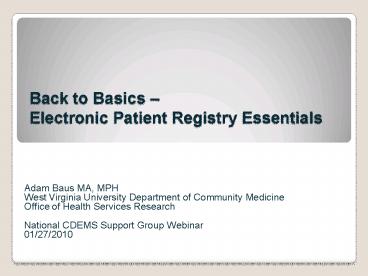Back to Basics - PowerPoint PPT Presentation
1 / 11
Title:
Back to Basics
Description:
Electronic Patient Registry Essentials Adam Baus MA, MPH West Virginia University Department of Community Medicine Office of Health Services Research – PowerPoint PPT presentation
Number of Views:76
Avg rating:3.0/5.0
Title: Back to Basics
1
Back to Basics Electronic Patient Registry
Essentials
- Adam Baus MA, MPH
- West Virginia University Department of Community
Medicine - Office of Health Services Research
- National CDEMS Support Group Webinar
- 01/27/2010
2
Special Thanks to Our Funders
- This presentation was supported by
Grant/Cooperative Agreement Numbers
U32/CCU322734, U59/CCU324180-03, U50/CCU321344
from the Centers for Disease Control and
Prevention. - Its contents are solely the responsibility of the
authors and do not necessarily represent the
official views of the Centers for Disease Control
and Prevention.
3
If you don't know where you are going, you might
wind up someplace else. Yogi Berra
4
What has worked well?
- Registry linked to QI plan
- Part of a larger process (Care Model)
- Team approach
- Provider champion
- Targeted measures
- Avoids bloat
- Data are evaluated, and then used
- PDSA Cycle
- Plan for growth
- EMR/EHR implementation
- Linking CDEMS to EMR/EHR data
5
About Patient Registries - AHRQ
- Understanding what a registry is and why they are
useful is essential to success - Registries differ from EHRs / EMRs
- STRENGTH in disease management / reporting
- Available resource Registries for Evaluating
Patient Outcomes A Users Guide - Published by the Agency for Healthcare Research
and Quality (AHRQ) - Handbook for creating, operating and evaluating
registries - In simple terms What are good registry
practices? - Citation Gliklich RE, Dreyer NA, eds.
Registries for Evaluating Patient Outcomes A
Users Guide. (Prepared by Outcome DEcIDE Center
Outcome Sciences, Inc. dba Outcome under
Contract No. HHSA29020050035ITO1.) AHRQ
Publication No. 07-EHC001-1. Rockville, MD
Agency for Healthcare Research and Quality. April
2007.
6
Registries Then and Now
1974 E.M. Brooke, in a 1974 publication of the
World Health Organization, describes registries
for health information as a file of documents
containing uniform information about individual
persons, collected in a systematic and
comprehensive way, in order to serve a
predetermined purpose. 2007 AHRQ describes a
patient registry as an organized system that
uses observational study methods to collect
uniform data (clinical and other) to evaluate
specified outcomes for a population defined by a
particular disease, condition, or exposure, and
that serves one or more predetermined scientific,
clinical, or policy purposes.
7
Part 1 Registry Planning
- Key Questions
- Whats the purpose of the registry?
- Who are the stakeholders?
- Whats the scope and target population?
- Is it feasible?
- The registry team and advisors should be selected
based on expertise and experience. - Plan for registry governance and oversight
- Data access
- Publications
- Change management (EMR use, someday)
8
Part 2 Registry Design
- Focus on the major purpose of the registry
- Keep it practical, and achievable
- Data elements
- What data elements are absolutely necessary?
- Which are desirable but not essential?
- Where can the data be found?
- Are existing data available for import into your
registry?
9
Part 3 Registry Buy-In
- Buy-in effects the overall quality of the data
and whether or not the data are used - What are the goals?
- What are the incentives?
- California Clinics Receive Funding to Enhance
Chronic Disease Care, Using Electronic Registries - From the California HealthCare Foundation
http//www.rwjf.org/qualityequality/digest.jsp?id
8002cEMC-ND142 - Online Registry Improves Diabetes Care in Kansas
- From HealthCare IT News http//www.nxtbook.com/nx
tbooks/medtech/hitn0608//16 - WV FQHC received federal funding for CDEMS use
10
Part 4 Data Collection
Quality Assurance
- Quality data (and meeting your goals) depends on
proper registry structure, data definitions, user
training and problem solving - Points to consider
- Data collection
- Data cleaning
- Data storing
- Data monitoring / reviewing
- Reporting
11
Contact Information
Cecil Pollard, Director (304) 293-1080
cpollard_at_hsc.wvu.edu Trisha Petitte, Assistant
Director, Health Improvement Consultant (304)
293-1084 tpetitte_at_hsc.wvu.edu Mary Swim,
Applications Programmer, Technical
Support (304) 293-1079 mswim_at_hsc.wvu.edu
Adam Baus, Program Coordinator, Sr., Technical
Support (304) 293-1083 abaus_at_hsc.wvu.edu
Nell Stuart, Health Improvement
Consultant (304) 276-3785 nstuart_at_hsc.wvu.edu
Marie Gravely, Health Improvement
Consultant (304) 482-6016 mgravely_at_hsc.wvu.ed
u
Office website wvuohsr.org

